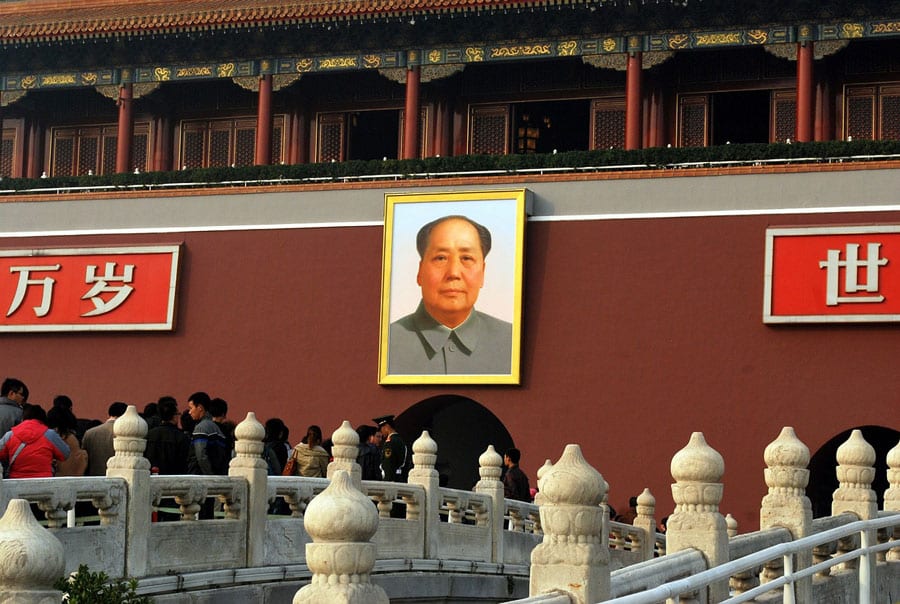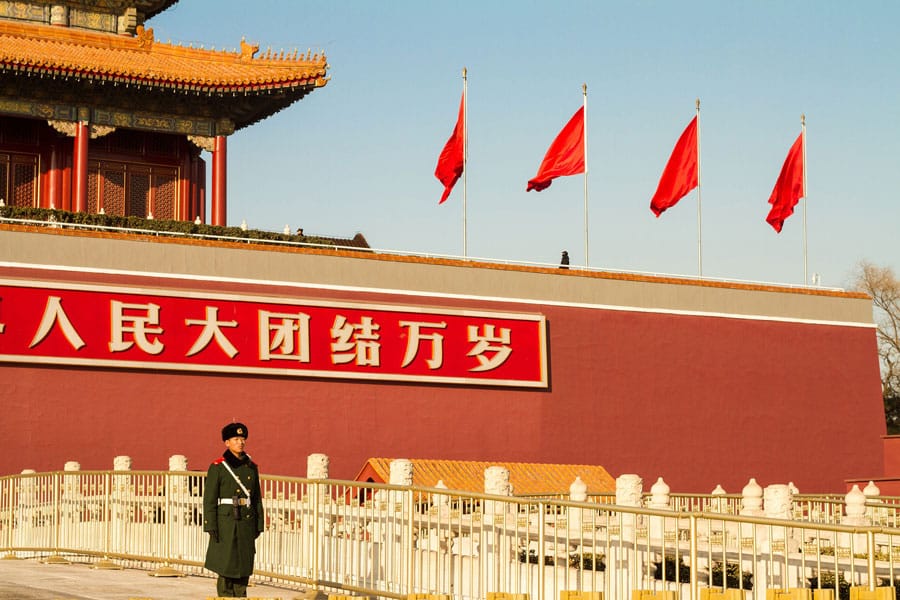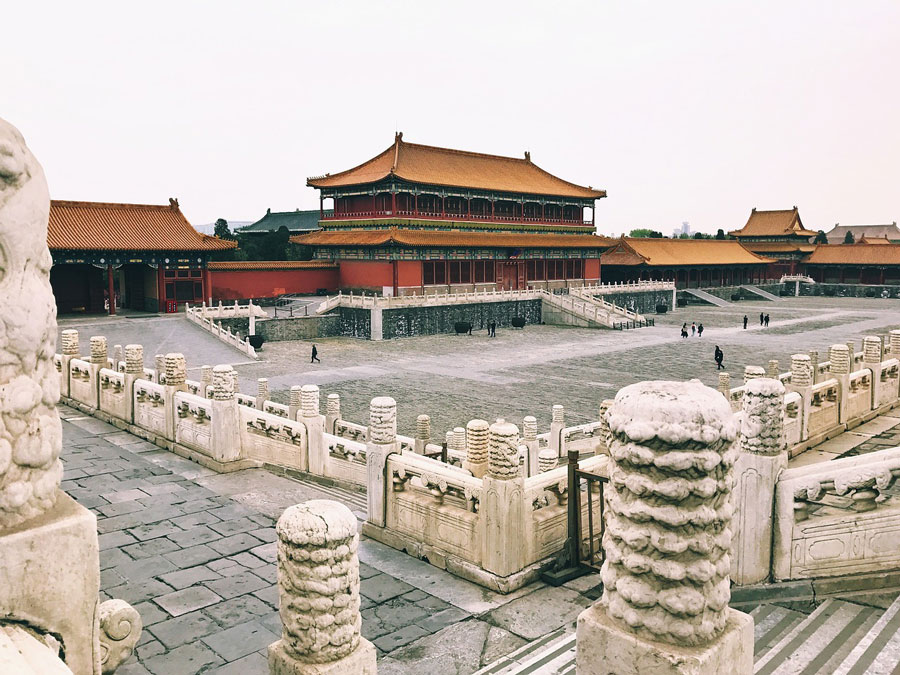Tiananmen Square, literally translated as “Square of the Gate of Heavenly Palace”, is a must-visit site in Beijing because of its history, cultural, and political significance. It is one of the biggest public squares in the whole world located on the core of the city’s north-south axis.
The area of the present square is 440,000 square meters. Tiananmen is popular as a relaxing place for the locals to walk as well as unwind and fly kites. During the holidays in China, Tiananmen Square is covered with fresh flowers.
History of Tiananmen Square
The public square was initially designed and constructed in 1651; however, in 1958, it was enlarged to four times its initial size. It got its name from the huge stone Tiananmen or “gate of Heavenly Palace” which was first built in 1417. This was once the main gate of the Forbidden City located at the northern end of the royal palace.
Attractions
Tiananmen Tower
On the northern side of the square, you can find the Tiananmen Tower, which was originally built in 1417 during the reign of the Ming Dynasty. Its most significant use in history was at the time of a huge ceremony. The tower was used to declare to the common people that the emperor and the empress will attend the ceremony. Since it was built, only the royal family and aristocrats could enter the Tiananmen Tower and it was only opened to the public when the last feudal kingdom ceased in 1911.
Monument to the People’s Heroes
At the center of Tiananmen Square, the Monument to the People’s Heroes exists, which was built to remember the people’s heroes in modern Chinese history. Its construction started on August 1, 1952, and was completed on April 22, 1958. It is considered the biggest monument in the history of China and it was chosen as one of the country’s foremost protected relics in 1961.
Sections
The monument covers an area of 3,000 square meters with a square shape. It has three body parts namely the body, the base (with the Buddhist-style), and the pedestal (with a height of 37.94 meters).
Material
The monument’s body is made up of granite, 413 pieces in total with 32 layers depth.
Carvings
In the middle of the north side of the monument, there is a piece of stone wherein an inscription of Mao Zedong words is engraved as “Eternal Glory to the People’s Heroes”.
Besides, on the south side, 7 pieces of stone exist with quotations from Mao Zedong inscribed by Zhou Enlai. The east and west sides have no inscriptions but there are carvings of pattered five-pointed stars, pine trees, and flags.
The monument has two layers of Buddhist-style bases. The upper, which is the smaller one, has a carving with a design of eight garlands composed of peony, chrysanthemum, lotus, and other flowers. The bigger one below is surrounded by 10 huge marble bas-relief, 8 of which signifies some of the revolutionary events in the modern history of the country.
The Pedestal
Lastly, the pedestal of the monument has two layers that are bordered by columns and steps.
Great Hall of the People
In the western part of Tiananmen Square, you can find the Great Hall of the People. It was built for a duration of 10 months only from October 1958 to September 1959. The building has an area of 171,800 square meters made it the largest hall structure in the world.
Sections
The Great Hall of the People has 3 sections. Its central part houses the Great Auditorium and the Central Hall, while its northern part has the Salute State Guest Hall, State Banquet Hall, and other stunning halls. The last section, which is the southern part, is composed of the administrative building of the Standing Committee of the People’s Congress of China. The Great Hall also houses one hall for each of the country’s provinces, special administrative regions, and autonomous regions like the Hong Kong Hall, Taiwan Hall, Beijing Hall, and others.
The Great Hall of the People As a Political Hub
Considered as the political hub of Beijing and the base of the National People’s Congress, the Great Hall of the People hosts the Liang hui (two meetings) every year which takes place in March. Representatives of the Chinese People’s Political Consultative Conference and the National People’s Congress attend in sessions at the Great Auditorium that lasts between 2 to 3 weeks. The National Congress, which is held every 5 years, is also conducted in the Great Hall by the Communist Party of China (CPC).
The Great Hall of the People As An Attraction
When national conferences are not in session, the hall is open to the public with a selection of routes. Some non-political conventions and concerts were held in the enormous building in recent years.
Memorial Hall of Chairman Mao
This is the resting place of Mao Zedong, the Chairman of the Politburo of China’s Communist party from 1983 and the chairman of the party’s Central Committee from 1945 until 1976. Located at the east of Tiananmen Square, the Memorial Hall of Chairman Mao covers a total area of about 57000 square meters. The building’s foundation was laid in November 1976 and the inauguration was conducted in September 1977. At the top of the mausoleum’s main gate, there is a white marble plaque where the golden words “Chairman Mao Memorial Hall” are carved.
Clay Figures
There are two groups of clay figures that were sculpted and placed in the south and north gates of the memorial hall, which depict the China revolution in the New Democracy period and the socialist construction period. The groups are composed of four teams and 62 clay figures with a measurement of 3.5 meters each. Outside the south gate, there are the 30 red flags, which represent the 30 municipalities, provinces, and autonomous regions.
The main body of the building is where the memorial halls are located on two floors.
The First Floor
The first floor houses the Northern Great hall, the Memorial Hall, and the South Great Hall. The entrance to the Memorial Hall and the place of holding the commemorative rites is in the North Great Hall. The Memorial Hall, on the other hand, is located at the center. This is the place where people pay tribute to the Chairman.
The body of Mao Zedong, which is placed in a crystal coffin, is clothed in Sun Yat Sen’s uniform and covered with the Communist Party’s flag. The base of the crystal coffin is made of granite and the national emblem, party emblem, army emblem, the birthday, and the day of death of Mao Zedong are engraved on it. The South Great Hall, which is the last hall on the first floor is the Memorial Hall’s exit point.
The Second Floor
The halls of the second floor are the memorial rooms for the revolutionary accomplishments of Mao Zedong, Liu Shaoqi, Zhou Enlai, Chen Yun, Deng Xiaoping, Zhu De, and besides, there is a movie hall here as well. There are marble statues of the six mentioned leaders in each of the memorial rooms designed with various materials such as literature and photos to describe their marvelous achievements in the China Revolution and Construction periods.

National Museum of China
On the east side of Tiananmen Square, you can find the China National Museum constructed in 2003. It offers a combination of a Chinese Revolutionary Museum and a Chinese History Museum. Inside the building, there are material objects, books, pictures, and models that depict the development of modern China. The History Museum also has a huge collection of cultural relics that illustrate the long and vast history as well as the glorious culture of China from 1.7 million years ago until 1921.
Flag Raising Ceremony
Seeing the guard in Tiananmen Square, who rise the national flag of China, is a must for all the visitors of Beijing. A lot of tourists get up early and go to the square before sunrise to witness the ceremony. The flag-raising ceremony at Tiananmen Square has a daily schedule for the year so ensure to check online first, you may be attending the large-scale ceremony where a military band accompanies the flag raising.

Japanese Occupation
Tiananmen Square has been a significant place in Beijing ever since it was built; however, the importance increased when China transferred from an emperor-led political culture to one that is ruled by the Communist Party. he last dynastic power that was able to govern China was the Qing dynasty. It ruled the country from the mid-1600 to 1912.
During the Xinhai Revolution that occurred from 1911-1912, the Qing was overthrown and the Republic of China was established. The first years of the Republic were under political turmoil and the country even fell under the Japanese government during this time until World War II. Throughout the Japanese occupation, there were about 20 million Chinese that were killed.
National Day
When Japan left China after the Second World War, the country entered a civil war period. In 1949, when the civil war ended, mainland China was possessed by the Communist Party who established the People’s Republic of China led by Chairman Mao Zedong.
To honor the occasion, a celebration was held in Tiananmen Square on October 1, 1949. The Chinese people who attended the historic event were estimated to be at 1 million.
The mentioned celebration is known as National Day, which is still observed every year on the same date. Large events are now held in the square annually to commemorate the occasion.
From the 1950s, the locations around Tiananmen Square has experienced several expansions. The square now boasts the Great Hall of the People wherein the Chinese Parliament and National People’s Congress’ annual meeting is held. The square is also the home of the National Museum of China which is a known art and history exhibition space.
Mao Zedong, known as the People’s Republic of China’s founding father, was also laid to rest at the square, in the plaza’s mausoleum.
The Protests in The Square
Pro-Democracy Demonstrations
The Tiananmen Square of China became well-known worldwide since it was the location of the Tiananmen Square Massacre, which took place on June 4, 1989. Even though the 2-day massacre is the reason for the square popularity in the world, it should be mentioned that the event is much more than that.
The pro-democracy protesters who were mostly composed of students occupied the square since the early days of May 1989. The reason for their rallies was their frustration with the limited political freedom in the country evidenced by the one-party form government (Communist Party) and the ongoing economic turmoil.
Although the country’s government developed several reforms in the 1980s that made way for a limited form of capitalism in China, many of the working class and poor Chinese still struggled and faced different challenges such as insufficient jobs and poverty growth.
The students also pointed out that the country’s education system did not sufficiently prepare them to be equipped for an economic system with the essentials of free-market capitalism.
To sum it up, the Tiananmen Square’s protests shouted for democracy, free speech, free press, and other reforms. The Chinese leaders’ thoughts about the protest were divided, some sympathized with the protesters while others saw them as threats to the political system.
Martial Law
As the days progressed, more and more people joined the protest and they reached 1 million by the end of May. Marches and vigils were held every day and media coverage was present to show images of the events to the people in other continents such as the US and Europe.
On May 13, several students started a hunger strike which enthused other protests and similar strikes all over China. The Chinese government felt uneasy as the movement grew especially when the visit of the Soviet Union’s Prime Minister Mikhail Gorbachev was disrupted on May 15.
Gorbachev was supposed to be welcomed in a ceremony in the square but the host country decided to hold the welcome ceremony in the airport instead to avoid any incident.
The Chinese government felt that the demonstrations needed to be stopped so a martial law was declared on May 20 and a total of 250,000 troops were dispersed to Beijing.
Tiananmen Square Massacre
The initial presence of the military wasn’t able to suppress the protests so the government ordered to increase hostility. On June 4, at around 1 am, the Chinese soldiers and police force entered Tiananmen Square and fired living rounds to the crowd of protesters.
Many of the protest participants tried to escape but some fought back by stoning the troops and setting fire to the martial trucks. The Western media and reporters who witnessed the even estimated that there were hundreds to thousands of protesters that were killed during the massacre and about 10,000 were arrested by the police.
Many leaders of other countries, including the country’s previous visitor Gorbachev, condemned China’s military action, and within a month, the United States Congress voted to enforce economic sanctions to the country stressing on human rights violations.
On June 5, around 70,000 people in Hong Kong gathered and held a memorial vigil for the massacre’s victims.

Tourist Guide
[wpsm_colortable color=”main-color”]
| How to get to | |
|---|---|
| By Subway | You can take subway line 1 to Tiananmen Dong or Tiananmen Xi Station or subway line 2 and leave at the Qianmen Station. |
| By Bus (Tiananmen Xi) | Buses 1, 5, 52, Sightseeing Bus Line 1, Sightseeing Bus Line 2, and Tourist Bus Line 2 help you to reach the square. |
| By Bus (Tiananmen Dong) | Buses 1, 2, 52, 59, 82, 120, Sightseeing Bus Line 2, or Tourist Bus 2 help you to reach the Tiananmen Dong. |
| By Bus (Tiananmen Guangchang) | Buses 1, 2, 5, 120, and Sightseeing Bus Line 2 can also take you to Tiananmen Guangchang Dong |
| By Bus (Tiananmen Guangchang Xi) | Bus 120 and Sightseeing Bus Line 2 also stop at Tiananmen Guangchang Xi. |
| Prices | |
| Entrance | Visiting the square is free but ascending the Tiananmen Tower costs CNY 15. |
| Opening Hours | |
| Every Day | You can visit the Tiananmen Square anytime but you should check the flag-raising and flag-lowering times online if you want to witness such. |
[/wpsm_colortable]
As a tip, try not to bring a lot of baggage with yourself because there is a security check you have to go through, and you should wait some time for checking the baggage. Have you ever visited this famous square? Feel free to share your comments and thoughts. Also, if you have any questions, feel free to leave them and our professional guides will reply as soon as possible.































